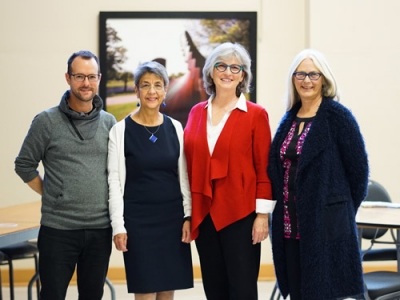By Lesley Barry
At 6 p.m. on February 2, 2018, when the referee tossed the ball and play began between the Carleton Ravens women’s basketball team and arch rivals the Ottawa Gee-Gees, groups of die-hard fans were dotted about the 18,000-seat Canadian Tire Centre.
It was the night of the Capital Hoops Classic, a major fixture on Carleton’s calendar, and an invitation to feel the pride, wear your colours (black and red, if you wanted to be on the winning side), and have some fun. More than 8,500 tickets had been sold for the double header— women at 6 p.m., men at 8 p.m. as usual — but by game time, just a couple hundred spectators had arrived.
After a fast start for the Ravens, the play tightened up. The women pounded up and down the court while spectators trickled in. As the Ravens made decisive gains in the final quarter, the seats in the lowest tier were filling up, and by the time the game ended with a score of 57-41, the Ravens clocking their 19th win of the season—and breaking the record for the most inter-conference wins in a row for women’s basketball—a party atmosphere was fizzing in the stands.
W🏀 FINAL | #Ravens win 3rd straight #CapitalHoops and tie Ontario regular season record with 37th consecutive win. #GoRavens pic.twitter.com/uzI7BvY0zP
— Carleton Ravens (@CURavens) February 3, 2018
The women came off the court, spent a few minutes with fans and photographers, and left for the change rooms. The spectators kept arriving. At 8 p.m., the men took their places, the ball went up, and 8,500 fans cheered.
The women’s warm-up act was over, and the real event of the night had begun. Clearly at least one newsroom felt that way. When the women’s team opened up one of the city’s newspapers the next morning, there was a full-page spread on the men’s program and the men’s team at Capital Hoops.
And for the women?
“They didn’t even print our score,” says Heather Lindsay, who has played centre for the Ravens for five years. “We deserved more respect than that.”

Seeking a Better Reputation for Women in Sport
So she sent out a tweet, tagging the newspaper. While she didn’t hear back from the paper, she got a lot of supportive comments, and Sportsnet picked up on the story.
“I tweeted because I wanted a better reputation for women’s sport,” Lindsay reports. “There are all these girls who follow us and want to play like we do one day. For them to look in the newspaper and find nothing at all about our game seemed like a real setback for women’s sports.”
But it isn’t just a setback. This is the way it is. Women’s teams and women athletes can show a lot of guts, but they rarely get the glory.
When the women’s team won their first national championship just weeks later, and the men’s took bronze, some media outlets were still placing the men’s story more prominently.
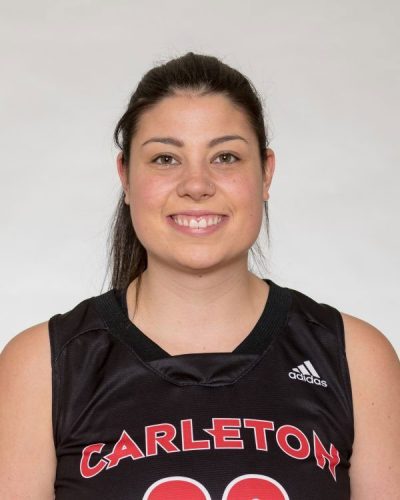
Heather Lindsay
The degree and extent to which sports remains a man’s world in Western society goes unnoticed because it feels so normal. Catch the news on the radio or television: the sportscast at the end will likely be narrated by a man, a male sports editor will have chosen what’s newsworthy, and the talk will be about male athletes, male teams and male competitions. Weekend television and the specialty sports networks show the same. The sports pages in newspapers and webpages on news sites? Overwhelmingly male, with ads targeted at men to match. Same again for the many websites devoted to analyzing, critiquing and discussing different sports and segments of sport.
This is what Canadian sports media looks like when just four per cent of televised coverage and 5.3 per cent of print coverage deal with women’s sports, as the Canadian Association for the Advancement of Women and Sports and Physical Activity (CAAWS) noted in a 2016 report—and over half of that four per cent was devoted to women’s tennis and coverage of the Winter Olympics. It feels normal because it has always been this way. It feels normal until you notice the daily absence of athletes who are women, and then the absence of women can begin to feel strange.
“Because men’s sports are all that’s available in the media, we’re all socialized from a young age to value men’s sports over women’s,” says Allison Sandmeyer-Graves, CEO of CAAWS. “You see that reflected in audience numbers and in the media coverage, and these two things reinforce one another.”
It’s easy to find another interpretation. Read an online article analyzing the lack of coverage of women’s events and you’ll find comments like: “if the quality was there, then spectators would come” or “the women’s game isn’t as exciting to watch” and “there are physiological differences that make men better athletes.” These sentiments are shared, all too often, by men who control promotion and sponsorship dollars.
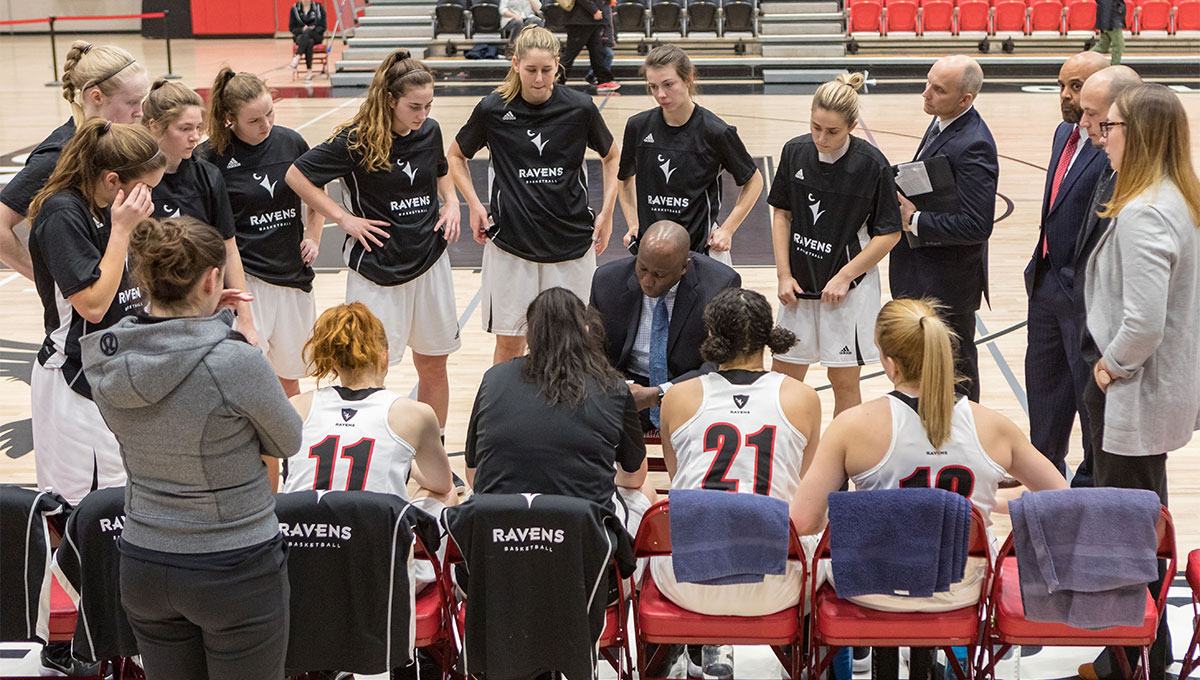
A Technical Game with More Character
But for Taffe Charles, the women Ravens’ basketball coach—as well as for the many fans of the WNBA and women’s NCAA basketball teams in the United States — that doesn’t mean the women’s game is a lesser product.
“If you deem playing above the rim as exciting, and many people do, then you’ll prefer the men’s game,” says Charles. “The women’s game has just as much character. The play is more technical and matches tend to be closer, so there’s more drama.”
“The pace, the hard hits, the hard tackles, whatever aspect is valued in men’s sports may not translate to women’s sports,” says Sandmeyer-Graves. “But women’s sports bring other things in terms of strategy, finesse and tactics that are awesome; they may just not be as apparent to the casual observer or to someone who’s been conditioned to think that it’s all about the dunks and the hits.
“Comparing the men’s version of the game and the women’s version of the game tends to position them in a hierarchy,” she continues, “where the men play it the way it was intended to be played and women play a lesser version. In fact, they each deserve to be valued and appreciated for their uniqueness.”
The “not as good” and “not as interesting” charges directed at women’s sports begin to crack in the face of audience numbers for mega events like the women’s hockey final at any of the last four Winter Olympics or the 2015 FIFA Women’s World Cup, which set new records for soccer viewership in the U.S. and Canada.
When these women’s events had access to mainstream sports media platforms and widespread promotion, audiences showed up. Katie Lebel, assistant professor in the Department of Marketing Management at Ryerson’s Ted Rogers School of Management, points out: “From an attendance and viewership perspective, it’s all about funding. Funding better publicity around women’s sport and female champions will attract audiences. The women’s gold medal hockey game at the 2018 Olympics is a great example of what happens when people become familiar with the players and feel invested and get excited. The networks promoted it, and it was one of the Games’ most-watched events.”
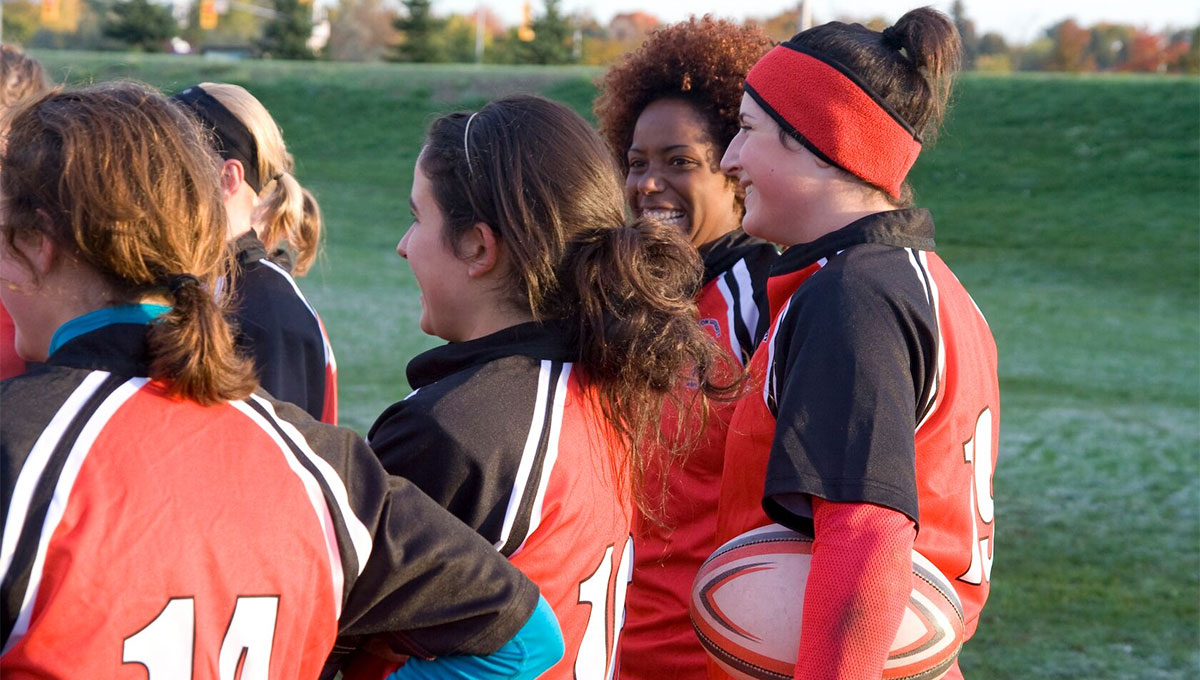
Examining Representation in Sports Media
Sports media is dominated by men. American figures suggest — and Canadian figures are believed to match them — that men comprise about 90 per cent of editors and assistant editors and 87 per cent of columnists and reporters. In televised sports news, about 95 per cent of anchors, co-anchors and analysts are men.
Countless academic studies have examined how female athletes are represented in sports media. One of the most interesting and eye-opening started in 1987 at the University of Southern California: at five-year intervals, researchers have compared and evaluated televised media coverage of men’s and women’s sports.
From 1989 to 2003, they found that sports commentary about female athletes tended to be openly sexist and denigrating. From 2004, “ambivalent” depictions began to be the norm, whereby female athletes were recognized for their achievements, but presented as wives, mothers or girlfriends.
“Part of improving women’s media coverage is following the coverage that does exist. Be that dedicated fan. To do that with the way sports media is set up today, you are going to have to do some work.” https://t.co/zO1se5zlL1
— HuffPost (@HuffPost) May 16, 2018
Then, in 2014, ambivalence was supplanted by “a matter-of-fact, monotonous, lacklustre delivery style of women’s sports coverage” that the researchers termed “gender-bland sexism.”
Over and over, the analysis revealed that segments on women’s sports lacked the excitement of the men’s, which would replay footage in slow-motion and from different camera angles, and feature “spectacular plays, breath-taking saves and competitive achievements.”
Commentators would announce women’s events in a monotone, then speak quickly and loudly, using flashy, descriptive words and action verbs like attacked, swarmed and exploded to present the men’s exploits.
NCAA swimmer Missy Franklin broke three records one day in the 200-yard freestyle and got the flat observation that she was “way ahead.” Elsewhere, the Philadelphia 76ers were having one of the worst seasons in NBA history but “commentators’ vocal intonations and jokes turned a less than inspiring game into an interesting one”— in other words, one worth watching.
Dedicated athletes are strong, determined and focused. Yet a large body of research shows only male athletes are consistently portrayed that way in images. Female athletes are, more often, posed, passive or looking tearful, or are out of their sports clothes and clad in fashionable outfits, emphasizing femininity over their athleticism. In other images, they may become sexual objects, clad in not much at all.
There are alternatives. Candice Ward’s photographs of Calgary Rage members, in the Western Women’s Canadian Football League, offer a refreshing counterpoint to the more common glamour shots of female athletes. According to CAAWS: “Her work offers a blueprint for how to capture and represent female athletes.”
When it comes to Instagram accounts of female athletes, Lebel finds that traditional images persist. “Many female athletes, especially elite female athletes, struggle to negotiate their strength and their success as athletes with the perceived need to conform to traditional expectations of femininity in the social sphere. And when they post more sexualized images, they can get two to three times the number of likes. They’re able to attract more sponsorship dollars, and since finances are still scarce in women’s sport, they’ve had to adapt to that strategy as a method of survival.”
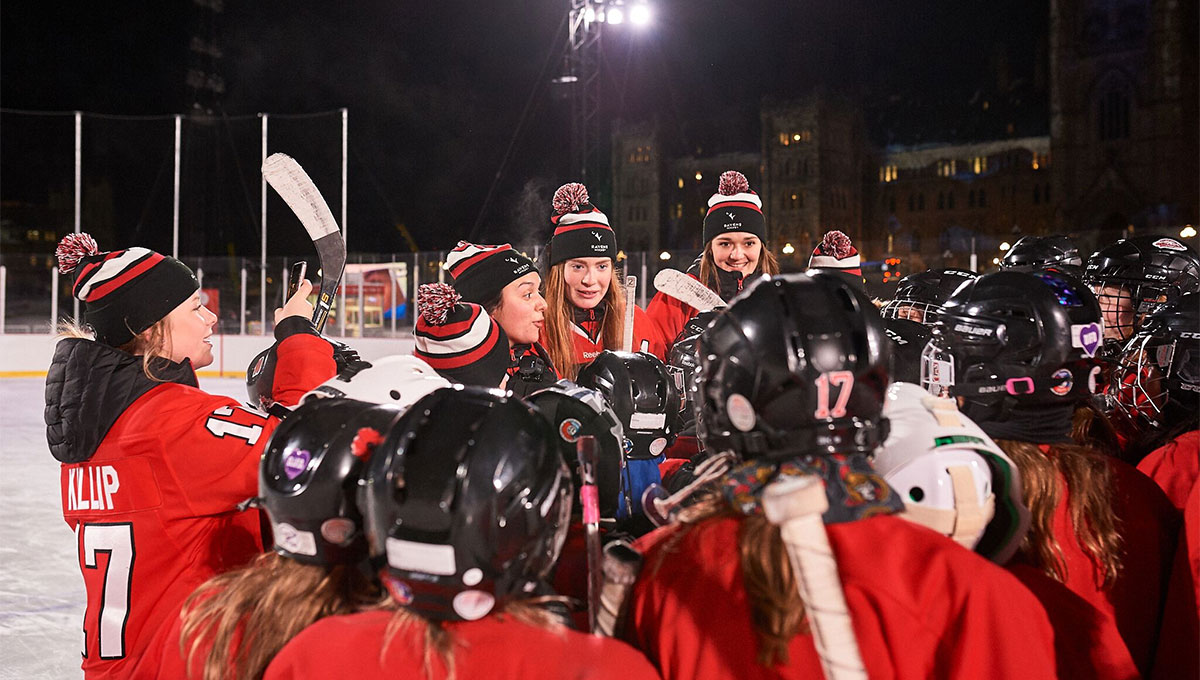
An All-Too Familiar Story
Here’s an all-too familiar story: The women’s swim team at the University of Toronto won the national championships and the men’s team didn’t. The student newspaper covered the men and not the women.
“I phoned them up,” recalls a former team member. “They said: ‘We only have one reporter.’ So I asked: ‘Why aren’t you sending the reporter to the better team’s event?’ There was no really good answer to that.”
The principal difference between this story and the ones about the Ravens women’s basketball team? It happened in 1980, 38 years ago.
The swimmer who complained was Nancy Lee, who started with CBC Sports in 1987 as the network’s first full-time national female sports reporter at CBC Radio and was the first female executive director of CBC-TV Sports from 2000 to 2006. Lee credits her early experience on the swim team for her inclusive approach to sports programming.
Lee has had a long time to assess media bias. Her conclusion? Lack of awareness.
“There are three types of people in media when it comes to portraying women in sport. About 15 per cent understand they need to treat women respectfully and fairly. At the other end, 25 per cent don’t get it and aren’t interested. The sexist group is part of that. Forget the 25 per cent — they’re a loss. The opportunity is with the 60 per cent in the middle, who just aren’t aware.”
Asked to make a presentation on women’s sport coverage to the Press Committee of the International Olympic Committee a few years back, Lee decided to look at the competition schedules from the Sochi and Vancouver Winter Olympics.
“Over and over I found instances of women’s events being scheduled on weekdays instead of weekends, when there’s more coverage, or before or after prime-time hours. Men’s events took precedence. I said to the committee: ‘Don’t blame the media for not covering female athletes on the last day of the Olympic Games at Sochi or Vancouver when you didn’t schedule any games for women on the last day.’ People at the table literally did a face palm.”
The final day at Pyeongchang this year featured the women’s curling gold medal game and 30-kilometre mass start cross-country ski event.
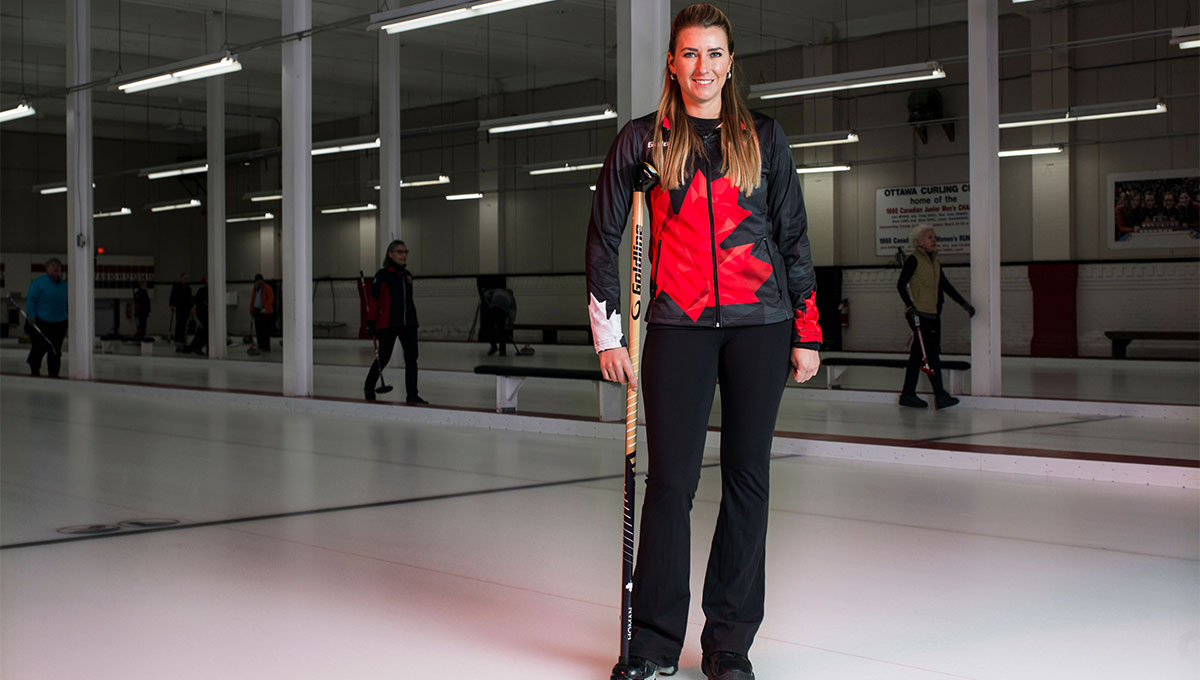
A Pervasive Lack of Awareness
If the primary problem is a pervasive lack of awareness, then the solution is comparatively easy, and it can applied at every level where bias and inequity appear—including the local level.
For Lee, the absence of any mention of the Ravens women at the Capital Hoops game in the city newspaper is an opportunity.
“I commend the student, Heather Lindsay, for taking action. Consumers need to speak up when there’s something wrong and if enough people do that, then media outlets will start to pay attention.
“But for sustained change, there needs to be a conversation. There’s a role for the leadership —whether from the athletics department or the communications department—to go with the student athletes to the editor and ask for a conversation to understand the way they are thinking and why the decision was made not to cover the women’s game. Then you get to awareness, and you can negotiate to make changes happen.”
Everyone needs to be mindful, Lee says.
“When I speak to sports organizations about gender equity, I ask them: ‘Before you go to that newspaper or media organization, what are you doing yourself?’ Lee advises they do a content analysis of their own communications, including their website, promotional videos and brochures, to check whether women and men are being treated equally, and then create a gender-balance style guide setting out how both genders should be depicted.
“Promoting women in sport is a priority at Carleton, where we highlight our women’s accomplishments on the goravens.ca website, through social media and posters around campus,” says Jennifer Brenning, assistant vice-president (Recreation and Athletics).
“Carleton’s women student-athletes are role models to the youth in the community, It is important for young girls and women to see they have opportunity to continue participating in high-level sport.”
The university also plans a series of stories to profile some of its outstanding women athletes and looks for opportunities to include them in publicity campaigns.

Making Women Athletes a Priority
“Unfortunately Canadian university sport is not getting much (media) coverage of any kind these days, male or female,” says Brenning. “U Sports is unable to get a national TV deal. The sports journalism landscape has changed significantly with severe cutbacks and traditional sports media are centralized at major corporations, focused on professional sport.”
It’s a missed opportunity for media outlets, says Lee.
“This is a generalization, but in many cases, sports media have topped out on how many men are reading, tweeting, streaming and viewing. The growth area is in women and I don’t understand why companies don’t see that.”
For CAAWS’ Sandmeyer-Graves, equity provides a valuable guideline for making changes.
“Equity takes the position that in order for both genders to have the same outcome—let’s say audience numbers—sometimes different outputs or different supports are needed. Standard marketing practices will likely fill the gym for the men’s basketball game on Friday night at any given university, but if you want a full gym for the women’s event too, the same suite of tactics might not work. You may need to innovate.”
She suggests looking at different or more marketing, or, similar to the rescheduling of women’s events at the Winter Olympics to increase exposure, changing the order of basketball games so that the men play at 6 p.m. and the women at 8 p.m.
A different marketing strategy that many women’s sporting events have adopted is to appeal to families, according to Lebel. She notes that women’s sports events tend to have lower ticket prices, making it more economical for families to bring their children.
Lee has been busy co-ordinating a major initiative for the International Olympic Committee that’s a potential game-changer for women’s sports: the IOC Gender Equality Review Project. The entire review, released in April, contains 25 recommendations and 80 detailed actions.
“Everybody was so tired of talking about the problems,” says Lee. “We were mandated not to be aspirational but to identify practical actions that national sports organizations and international federations could work on with the IOC. Some of the actions say that we need more research or more funding, but others are quite specific.”

Moving Toward Equity
One idea for change discussed by leaders in women’s sport – pressing for a measurable increase in how much media content is directed to women’s sports.
“It would be a way of enforcing that, in this day and age, if you are a sports broadcaster, you have to start moving toward equity in your programming,” says Marion Lay, a former Olympian who has been advocating for women’s sports since 1972 when she set up a women and sport program at the federal agency for sports.
“You can’t have 1,000 hours of men’s sports and then, during the Olympic Games, run 25 hours of women’s sports. That’s not okay.”
As long as media coverage limits interest in women’s sport, viewership numbers, ticket sales, salaries, sponsorships and advertising—resources that athletes and organizations need for growth—will suffer.
But there is good news. The last federal budget contained $30 million over three years to address issues facing girls and women in sport has been energizing. “It’s never happened before,” says Lee. “Hopefully the money will be spent wisely and not on reinventing the wheel. But the key is women’s sports is on the agenda.”
Lay, from her nearly 50 years in the trenches, is optimistic.
“A lot more young women and girls are asking for things to be different. But it isn’t just women. There’s a lot of pressure on the sport system to change. The models of the past that are exclusionary — of women, people with disabilities, First Nations—have to change, because we all have the right to be able to participate fully in our society. I think that’s the challenge ahead.”
Thursday, July 26, 2018 in Athletics
Share: Twitter, Facebook

